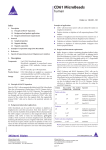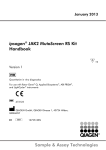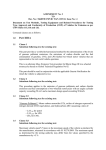Download AssayMaxTM Canine Fibrinogen ELISA Kit
Transcript
AssayMaxTM Canine Fibrinogen ELISA Kit Assaypro LLC 3400 Harry S Truman Blvd St. Charles, MO 63301 T (636) 447-9175 F (636) 395-7419 www.assaypro.com For any questions regarding troubleshooting or performing the assay, please contact our support team at [email protected]. Thank you for choosing Assaypro. Assay Summary Step 1. Add 50 µl of Standard or Sample per well. Incubate 2 hours. Step 2. Wash, then add 50 µl of Biotinylated Antibody per well. Incubate 1 hour. Step 3. Wash, then add 50 µl of SP Conjugate per well. Incubate 30 minutes. Step 4. Wash, then add 50 µl of Chromogen Substrate per well. Incubate 20 minutes. Step 5. Add 50 µl of Stop Solution per well. Read at 450 nm immediately. Symbol Key Consult instructions for use. H G F E D C B A 1 2 3 4 5 6 7 8 9 10 11 12 Assay Template Canine Fibrinogen (FBG) ELISA Kit Catalog No. ECF2040-1 Sample insert for reference use only Introduction Fibrinogen (FBG) is a homodimer (340 kDa) that is made up of two sets of alpha, beta, and gamma polypeptide chains. FBG is synthesized in the parenchymal cell of the hepatocyte and in the megakaryocyte (1). FBG plays a major role in coagulation. Upon cleavage by thrombin in the initial stages of coagulation activation, FBG self-assembles to yield a fibrin clot matrix that subsequently is crosslinked by factor XIIIa to form an insoluble network. FBG also binds to the platelet glycoprotein IIbIIIa receptor to form bridges between platelets, thus facilitating aggregation (2). Principle of the Assay The AssayMax Canine Fibrinogen ELISA (Enzyme-Linked Immunosorbent Assay) kit is designed for detection of canine FBG in urine and cell culture media samples. This assay employs a quantitative sandwich enzyme immunoassay technique that measures canine FBG in less than 4 hours. A polyclonal antibody specific for canine FBG has been pre-coated onto a 96well microplate with removable strips. FBG in standards and samples is sandwiched by the immobilized polyclonal antibody and biotinylated polyclonal antibody specific for canine FBG, which is recognized by a streptavidin-peroxidase conjugate. All unbound material is washed away and a peroxidase enzyme substrate is added. The color development is stopped and the intensity of the color is measured. Caution and Warning This product is for Research Use Only and is Not For Use In Diagnostic Procedures. Prepare all reagents (working diluent buffer, wash buffer, standard, biotinylated antibody, and SP conjugate) as instructed, prior to running the assay. Prepare all samples prior to running the assay. The dilution factors for the samples are suggested in this insert. However, the user should determine the optimal dilution factor. Spin down the SP conjugate vial and the biotinylated antibody vial before opening and using contents. The Stop Solution is an acidic solution. 1 The kit should not be used beyond the expiration date. Reagents Canine FBG Microplate: A 96-well polystyrene microplate (12 strips of 8 wells) coated with a polyclonal antibody against canine FBG. Sealing Tapes: Each kit contains 3 precut, pressure sensitive sealing tapes that can be cut to fit the format of the individual assay. Canine FBG Standard: Canine FBG in a buffered protein base (800 ng, lyophilized). Biotinylated Canine FBG Antibody (100x): A 100-fold concentrated biotinylated polyclonal antibody against canine FBG (80 l). EIA Diluent Concentrate (10x): A 10-fold concentrated buffered protein base (30 ml). Wash Buffer Concentrate (20x): A 20-fold concentrated buffered surfactant (30 ml, 2 bottles). Streptavidin-Peroxidase Conjugate (SP Conjugate): A 100-fold concentrate (80 l). Chromogen Substrate: A ready-to-use stabilized peroxidase chromogen substrate tetramethylbenzidine (8 ml). Stop Solution: A 0.5 N hydrochloric acid to stop the chromogen substrate reaction (12 ml). Storage Condition Upon arrival, immediately store components of the kit at recommended temperatures up to the expiration date. Store SP Conjugate and Biotinylated Antibody at -20°C. Store Microplate, Diluent Concentrate (10x), Wash Buffer, Stop Solution, and Chromogen Substrate at 2-8°C. Unused microplate wells may be returned to the foil pouch with the desiccant packs and resealed. May be stored for up to 30 days in a vacuum desiccator. Diluent (1x) may be stored for up to 30 days at 2-8°C. Store Standard at 2-8°C before reconstituting with Diluent and at -20°C after reconstituting with Diluent. Other Supplies Required 2 Microplate reader capable of measuring absorbance at 450 nm. Pipettes (1-20 l, 20-200 l, 200-1000 l, and multiple channel). Deionized or distilled reagent grade water. Sample Collection, Preparation, and Storage Urine: Collect urine using sample tube. Centrifuge samples at 800 x g for 10 minutes. Dilute samples 1:4 with EIA Diluent and assay. The undiluted samples can be stored at -20°C or below for up to 3 months. Avoid repeated freeze-thaw cycles. Cell Culture Media: Centrifuge cell culture media at 3000 x g for 10 minutes to remove debris. Collect supernatants and assay. Store samples at -20°C or below. Avoid repeated freeze-thaw cycles. Refer to Sample Dilution Guidelines below for further instruction. Guidelines for Dilutions of 1:100 or Greater (for reference only; please follow the insert for specific dilution suggested) 1:100 1:10000 A) 4 ul sample: 396 µl buffer(100x) = 100 fold dilution A) B) Assuming the needed volume is less than or equal to 400 µl. Assuming the needed volume is less than or equal to 400 µl. 1:1000 A) B) 4 µl sample : 396 µl buffer (100x) 24 µl of A : 216 µl buffer (10x) = 1000 fold dilution Assuming the needed volume is less than or equal to 240 µl. 4 µl sample : 396 µl buffer (100x) 4 µl of A : 396 µl buffer (100x) = 10000 fold dilution 1:100000 A) B) C) 4 µl sample : 396 µl buffer (100x) 4 µl of A : 396 µl buffer (100x) 24 µl of B : 216 µl buffer (10x) = 100000 fold dilution Assuming the needed volume is less than or equal to 240 µl. Reagent Preparation Freshly dilute all reagents and bring all reagents to room temperature before use. EIA Diluent Concentrate (10x): If crystals have formed in the concentrate, mix gently until the crystals have completely dissolved. Dilute the EIA Diluent Concentrate 1:10 with reagent grade water. Store for up to 30 days at 2-8°C. Standard Curve: Reconstitute the 800 ng of Canine FBG Standard with 1 ml of EIA Diluent to generate an 800 ng/ml standard stock solution. Prepare duplicate or triplicate standard points by serially diluting the standard stock solution (800 ng/ml) 1:2 with EIA Diluent to produce 400, 200, 100, 50, 25, and 12.5 ng/ml solutions. EIA Diluent serves as the zero standard (0 ng/ml). Any remaining solution should be frozen at -20°C and used within 5 days. 3 Standard Point P1 P2 P3 P4 P5 P6 P7 P8 Dilution 1 part Standard (800 ng/ml) 1 part P1 + 1 part EIA Diluent 1 part P2 + 1 part EIA Diluent 1 part P3 + 1 part EIA Diluent 1 part P4 + 1 part EIA Diluent 1 part P5 + 1 part EIA Diluent 1 part P6 + 1 part EIA Diluent EIA Diluent [Canine FBG] (ng/ml) 800.0 400.0 200.0 100.0 50.00 25.00 12.50 0.000 Biotinylated Canine FBG Antibody (100x): Spin down the antibody briefly and dilute the desired amount of the antibody 1:100 with EIA Diluent. Any remaining solution should be frozen at -20°C. Wash Buffer Concentrate (20x): If crystals have formed in the concentrate, mix gently until the crystals have completely dissolved. Dilute the Wash Buffer Concentrate 1:20 with reagent grade water. SP Conjugate (100x): Spin down the SP Conjugate briefly and dilute the desired amount of the conjugate 1:100 with EIA Diluent. Any remaining solution should be frozen at -20°C. Assay Procedure 4 Prepare all reagents, standard solutions, and samples as instructed. Bring all reagents to room temperature before use. The assay is performed at room temperature (20-25°C). Remove excess microplate strips from the plate frame and return them immediately to the foil pouch with desiccants inside. Reseal the pouch securely to minimize exposure to water vapor and store in a vacuum desiccator. Add 50 l of Canine FBG Standard or sample per well. Cover wells with a sealing tape and incubate for 2 hours. Start the timer after the last addition. Wash five times with 200 l of Wash Buffer manually. Invert the plate each time and decant the contents; hit 4-5 times on absorbent material to completely remove the liquid. If using a machine, wash six times with 300 l of Wash Buffer and then invert the plate, decanting the contents; hit 4-5 times on absorbent material to completely remove the liquid. Add 50 l of Biotinylated Canine FBG Antibody to each well and incubate for 1 hour. Wash the microplate as described above. Add 50 l of Streptavidin-Peroxidase Conjugate to each well and incubate for 30 minutes. Turn on the microplate reader and set up the program in advance. Wash the microplate as described above. Add 50 l of Chromogen Substrate per well and incubate for 20 minutes or till the optimal blue color density develops. Gently tap plate to ensure thorough mixing and break the bubbles in the well with pipette tip. Add 50 l of Stop Solution to each well. The color will change from blue to yellow. Read the absorbance on a microplate reader at a wavelength of 450 nm immediately. If wavelength correction is available, subtract readings at 570 nm from those at 450 nm to correct optical imperfections. Otherwise, read the plate at 450 nm only. Please note that some unstable black particles may be generated at high concentration points after stopping the reaction for about 10 minutes, which will reduce the readings. Data Analysis Calculate the mean value of the duplicate or triplicate readings for each standard and sample. To generate a standard curve, plot the graph using the standard concentrations on the x-axis and the corresponding mean 450 nm absorbance (OD) on the y-axis. The best-fit line can be determined by regression analysis using log-log or four-parameter logistic curve-fit. Determine the unknown sample concentration from the Standard Curve and multiply the value by the dilution factor. Typical Data The typical data is provided for reference only. Individual laboratory means may vary from the values listed. Variations between laboratories may be caused by technique differences. Standard Point P1 P2 P3 P4 P5 P6 P7 P8 ng/ml 800.0 400.0 200.0 100.0 50.00 25.00 12.50 0.000 Average OD 2.064 1.764 1.374 0.896 0.565 0.367 0.231 0.075 Standard Curve The curve is provided for illustration only. A standard curve should be generated each time the assay is performed. 5 H u m a n F B G S ta n d a r d C u r v e O D 450 nm 10 1 0 .1 10 100 1000 [F B G ] ( n g /m l) Performance Characteristics The minimum detectable dose of canine FBG as calculated by 2SD from the mean of a zero standard was established to be 7 ng/ml. Intra-assay precision was determined by testing replicates of three plasma samples in one assay. Inter-assay precision was determined by testing three plasma samples in twenty assays. Sample n CV (%) Average CV (%) Intra-Assay Precision 1 2 3 20 20 20 4.8% 5.1% 4.5% Inter-Assay Precision 1 2 3 20 20 20 9.1% 8.8% 9.1% 4.8% 9.0% Recovery Standard Added Value Recovery % Average Recovery % 6 20 – 400 ng/ml 89 – 111% 96% Linearity Average Percentage of Expected Value (%) Sample Dilution Urine 1:2 97% 1:4 96% 1:8 89% Cross-Reactivity Species Canine Bovine Monkey Mouse Rat Swine Rabbit Human Cross Reactivity (%) 100% None None None None <20% None <40% References (1) (2) Doolittle, R.F. (1984) Annu. Rev. Biochem 53:195 Handley, D.A. and Hughes, T.E. (1997) Thromb. Res. 87:1 Version 1.2R4 Related Products EF1040-1 AssayMax Human Fibrinogen ELISA Kit (Plasma samples) EF2040-1 AssayMax Human Fibrinogen ELISA Kit (Urine, Milk, Saliva, and Cell Culture samples) ECF1040-1 AssayMax Canine Fibrinogen ELISA Kit (Plasma samples) ERF2040-1 AssayMax Rat Fibrinogen ELISA Kit (Urine and Cell Culture samples) ERF1040-1 AssayMax Rat Fibrinogen ELISA Kit (Plasma samples) EMF2040-1 AssayMax Mouse Fibrinogen ELISA Kit (Urine and Cell Culture samples) EMF1040-1 AssayMax Mouse Fibrinogen ELISA Kit (Plasma samples) www.assaypro.com • e-mail: [email protected] 7



























